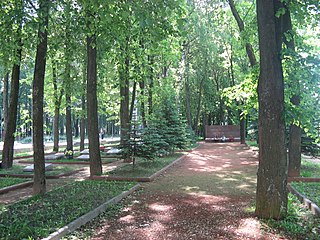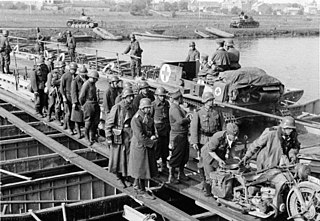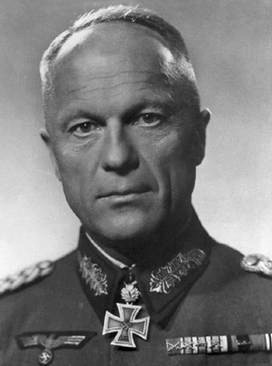
Konstantin Konstantinovich Rokossovsky was a Soviet and Polish officer who became a Marshal of the Soviet Union, a Marshal of Poland, and served as Poland's Defence Minister from 1949 until his removal in 1956 during the Polish October. He became one of the most prominent Red Army commanders of World War II.

The first Battle of Smolensk was a battle during the second phase of Operation Barbarossa, the Axis invasion of the Soviet Union, in World War II. It was fought around the city of Smolensk between 10 July and 10 September 1941, about 400 km (250 mi) west of Moscow. The Ostheer had advanced 500 km (310 mi) into the USSR in the 18 days after the invasion on 22 June 1941.

The Yelnya offensive was a military operation by the Soviet Army during the Battle of Smolensk during Operation Barbarossa, the German invasion of the Soviet Union, which began the German-Soviet War. The offensive was an attack against the semi-circular Yelnya salient which the German 4th Army had extended 50 kilometres (31 mi) south-east of Smolensk, forming a staging area for an offensive towards Vyazma and eventually Moscow. Under heavy pressure on its flanks, the German army (Heer) evacuated the salient by 8 September 1941, leaving behind a devastated and depopulated region. As the first reverse that the Heer suffered during Barbarossa and the first recapture of the Soviet territory by the Red Army, the battle was covered by Nazi and Soviet propaganda and served as a morale boost to the Soviet population.

The 29th Infantry Division was a unit of the German army created in the fall of 1936. It was based on the old Reichswehr 15th Infantry Regiment and drew its initial recruits from Thuringia. It was upgraded to 29th Motorized Infantry Division in the fall of 1937. The division was also known as the Falke-Division.

The 8th Panzer Division was a formation of the WehrmachtHeer. The division was formed by reorganising the 3rd Light Division in October 1939. It was transferred to the west and fought in the Battle of France, in May 1940, and the German invasion of the Balkans in April 1941. Soon after the division advanced towards Leningrad under Army Group North in Operation Barbarossa, and would remain on the eastern front for the remainder of the war. Staying on defensive fronts, it saw action in the relief of Kholm in 1942, Orel and the withdrawals of Army Group Centre in 1943, until transferred to Army group South. The division then fought in a series of retrograde movements, back through Ukraine, into Hungary and finally into Silesia and surrender in May 1945.

The 9th Panzer Division was a panzer division of the German Army during World War II. It came into existence after 4th Light Division was reorganized in January 1940. The division was headquartered in Vienna, in the German military district Wehrkreis XVII.

The 12th Panzer Division was an armoured division in the German Army, established in 1940.

The 12th Infantry Division – later known as the 12th Volksgrenadier Division – was a Wehrmacht military unit of Nazi Germany that fought during World War II. The division was formed in 1934. It participated in the invasion of Poland in 1939 and the 1940 campaign in France and the Low Countries. In the Soviet Union, the division joined Operation Barbarossa. The division was destroyed in the Soviet Operation Bagration in the summer of 1944. The division was re-activated in September 1944 and posted to the newly created Western Front.
The 7th Panzer Division was an armored formation of the German Army in World War II. It participated in the Battle of France, the invasion of the Soviet Union, the occupation of Vichy France, and on the Eastern Front until the end of the war. The 7th Panzer Division is also known by its nickname, Ghost Division.

The 17th Panzer Division was a formation of the Wehrmacht in World War II. It was formed in November 1940 from the 27th Infantry Division. It took part in Operation Barbarossa, the invasion of the Soviet Union in June 1941, and in the winter of 1941–42 participated in the Battle of Moscow. In November 1942, the division was sent to the southern sector of the Eastern Front where it participated in Operation Winter Storm, the failed attempt to relieve the surrounded troops at Stalingrad. The division was held in reserve during the Battle of Kursk in 1943, and thereafter retreated through Ukraine and Poland, before ending the war in Czechoslovakia.
The 101st Jäger Division was a light infantry Division of the German Army in World War II. It was formed in July 1942 by the redesignation of the 101st (Light) Infantry Division, which was itself formed in December 1940. The Walloon Legion was briefly attached to this division from December 1941 to January 1942. The Division took part in the Battle of Kharkov, the Battle of the Caucasus, and the retreat into the Kuban, where it suffered heavy losses fighting both the Red Army and partisans. The division was then involved in the battles in the Kuban bridgehead before being evacuated. The 101st was subsequently transferred to the lower Dnieper River in late 1943. It was part of the 1st Panzer Army that was surrounded in March 1944; it formed the rear guard for the XLVI Panzer Corps during the breakout of the Kamenets-Podolsky pocket. The division then retreated across Ukraine. In October 1944, it was moved to Slovakia and took part in the Battle of the Dukla Pass.

The 36th Infantry Division was a German infantry formation of World War II. It was formed in Kaiserslautern on 1 October 1936. During World War II it was mobilized in August 1939, as part of the first wave. It was later reorganized and re-designated the 36th Infantry Division (mot) in November 1940. It was then de-motorized, reorganized and re-designated the 36th Infantry Division on 1 May 1943. The division was destroyed at Bobruysk in June 1944 during the Soviet Operation Bagration. It was reformed on 3 August 1944 as the 36th Grenadier Division and renamed the 36th Volksgrenadier Division in October 1944.

The Battle of Sedan or Second Battle of Sedan took place in the Second World War during the Battle of France in 1940. It was part of the German Wehrmacht's operational plan codenamed Fall Gelb for an offensive through the hilly and forested Ardennes, to encircle the Allied armies in Belgium and north-eastern France. German Army Group A crossed the Meuse with the intention of capturing Sedan and pushing westwards towards the Channel coast, to trap the Allied forces that were advancing east into Belgium, as part of the Allied Dyle Plan.

Johann Mickl was an Austrian-born army officer and division commander who served Nazi Germany during World War II. Reaching the rank of general (Generalleutnant), he was one of only 882 recipients of the Knight's Cross of the Iron Cross with Oak Leaves. He was commissioned shortly before the outbreak of World War I, and served with Austro-Hungarian forces on the Eastern and Italian Fronts as a junior officer in the Imperial-Royal Mountain Troops. During World War I he was decorated several times for bravery and leadership and was wounded on four occasions.

The 31st Infantry Division was a German infantry division of the Army during World War II. It participated in the invasion of Poland in 1939 then the invasion of France and the Low Countries in 1940. As part of Panzergruppe 2. of Army Group Centre, it was involved in the invasion of the Soviet Union in June 1941. After hard fighting throughout 1941 and 1942 it joined the 9th Army and fought in the Battle of Kursk in July and August 1943. Along with the rest of the 9th Army, the division conducted a fighting withdrawal for the remainder of 1943, during which it sustained heavy casualties. In the early stages of the Soviet Operation Bagration of June to August 1944, the 31st Infantry Division was destroyed, a fate which subsequently befell most of Army Group Centre. The division was officially disbanded on 18 July 1944.

The 112th Infantry Division was a German Army infantry division active in World War II.
The 22nd Guards Rifle Division was unique in being the only Guards rifle division formed twice during the Great Patriotic War. It was first formed from the 363rd Rifle Division in March 1942. Soon after forming it provided a command cadre for the second formation of the 53rd Army in Kalinin Front. Later, in the fall of that year, the division provided most of its personnel and equipment to form the new 2nd Guards Mechanized Corps, and was then disbanded. In April 1943, a new 22nd Guards was formed from the second formation of the 150th Rifle Division in the Moscow Military District, and went on to serve for the duration in 10th Guards Army. This formation first saw service in Operation Suvorov, the summer offensive of Western Front that liberated Smolensk in late September, and then fought through the autumn and winter in grinding battles towards the city of Orsha. During the summer offensive of 1944 it helped break the Panther Line in western Russia and then advanced into Latvia, winning a battle honor for its part in the liberation of Riga, before ending the war in Lithuania, helping to contain the German forces trapped in the Courland Pocket. It was disbanded shortly after the war.
The 30th Guards Rifle Division was reformed as an elite infantry division of the Red Army in May, 1942, based on the 1st formation of the 238th Rifle Division, and served in that role until after the end of the Great Patriotic War. It would soon after help provide the headquarters cadre for the 7th Guards Rifle Corps along with its "sister" 29th Guards Rifle Division. However, it was not assigned as a unit to the Corps until August when it joined 33rd Army of Western Front and saw extensive fighting, while also suffering extensive casualties, in the summer campaign against the German 3rd Panzer Army in the southern sector of the Rzhev salient. After leaving 7th Guards Corps the division was reassigned to several other armies in the Front until April, 1943 when it joined the 15th Guards Rifle Corps in 30th Army, which became 10th Guards Army the next month; it would remain under these commands for the duration of the war. The division took part in Operation Suvorov, Western Front's summer offensive towards Smolensk, and after the liberation of that city was involved in several unsuccessful drives on the Belarusian city of Orsha. By December the 30th Guards had been redeployed to 2nd Baltic Front and during the summer and fall of 1944 it took part in the offensives through the Baltic states, winning a battle honor for its part in the liberation of Riga. For the rest of the war the division remained in Latvia helping to contain the German forces trapped in the Courland Peninsula, eventually coming under command of Leningrad Front. In mid-1946 it was converted to the 30th Separate Guards Rifle Brigade.
The 56th Guards Rifle Division was formed as an elite infantry division of the Red Army in June 1943, based on the 2nd formations of the 74th and 91st Rifle Brigades, and served in that role until after the end of the Great Patriotic War. Along with its "sister", the 65th Guards Rifle Division, the 56th was formed "out of sequence", that is, many Guards rifle divisions were higher numbered and formed earlier than the 56th. The division was immediately assigned to the 19th Guards Rifle Corps of the 10th Guards Army and remained under those headquarters for the duration of the war. It first saw action in Western Front's summer offensive, Operation Suvorov. On September 8 the 254th Guards Rifle Regiment was given the honorific title "in the name of Aleksandr Matrosov" and on September 25 the division as a whole was awarded the honorific "Smolensk" for its role in the liberation of that city. During the winter of 1943-44 it took part in the stubborn fighting north and east of Vitebsk, first in Western and later in 2nd Baltic Front. During the following summer offensives it helped break through the defenses of the German Panther Line and advanced into the Baltic states, eventually being decorated with the Order of the Red Banner after the liberation of Riga. For the rest of the war it was part of the forces blockading the remnants of German Army Group North in the Courland Pocket in Latvia, eventually in Leningrad Front. After the war the 56th Guards was moved to the town of Elva in Estonia where it was disbanded in 1947, although the successor formations of the 254th Guards Regiment exist into the present day.
The 65th Guards Rifle Division was formed as an elite infantry division of the Red Army in May, 1943, based on the 2nd formations of the 75th and 78th Rifle Brigades, and served in that role until after the end of the Great Patriotic War. Along with its "sister", the 56th Guards Rifle Division, the 65th was formed "out of sequence", that is, many Guards rifle divisions were higher numbered and formed earlier than the 65th. The division was immediately assigned to the 19th Guards Rifle Corps of the 10th Guards Army and remained under those headquarters for the duration of the war. It first saw action in Western Front's summer offensive, Operation Suvorov. During the winter of 1943-44 it took part in the stubborn fighting north and east of Vitebsk, first in Western and later in 2nd Baltic Front. During the following summer offensives it helped break through the defenses of the German Panther Line and advanced into the Baltic states, eventually receiving a battle honor for its part in the liberation of Riga. For the rest of the war it was part of the forces blockading the remnants of German Army Group North in the Courland Pocket in Latvia, eventually in Leningrad Front. After the war the 65th Guards was moved to Estonia where it was disbanded in 1947.














